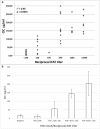Assessment of Circulating Immune Complexes During Natural and Experimental Canine Leishmaniasis
- PMID: 32509808
- PMCID: PMC7248327
- DOI: 10.3389/fvets.2020.00273
Assessment of Circulating Immune Complexes During Natural and Experimental Canine Leishmaniasis
Abstract
Canine leishmaniasis (CanL) is a disease characterized by a large variety of clinical alterations, the majority of which being due to immune mediated mechanisms. Sick dogs usually produce high levels of Leishmania-specific immunoglobulins which may give rise to circulating immune complexes (CICs) whose defective clearance by scavenging macrophages induces vasculitis and their deposition in specific organs. The aim of this study was to assess the serum level of CICs in dogs exposed to natural and experimental infection. Fifty-two sera were examined, belonging to untreated groups of naïve beagles previously studied to assess the performance of anti-leishmanial vaccines under natural (no. 22 dogs) or experimental (no. 30 dogs) transmission. Sera were classified in five groups according to the dog's health condition, IFAT titer, and the bone marrow (BM) nested (n)-PCR result. A: no.10 healthy dogs before the experimental infection; B: no.10 clinically healthy dogs infected experimentally, IFAT negative (= reciprocal titer <160) and n-PCR positive; C: no.10 clinically healthy dogs naturally infected, IFAT positive at titers 160-320 and n-PCR negative; D: no.10 sick dogs experimentally infected, IFAT positive at titer >320 and n-PCR positive; E: no.12 sick dogs naturally infected, IFAT positive at titer >320 and n-PCR positive. CICs levels were assessed by ELISA method (canine CIC assay-Cloude-Clone Corporation, USA). The two groups characterized by negative IFAT (A and B) had the lowest median level of CICs (16.09 and 12.78 μg/ml, respectively). CICs value increased progressively in the group C and reached the highest levels in the groups D and E, both characterized by high antibodies titer and severe disease, independently from the mode of infection. Significant differences in CICs concentration (p < 0.0001) were demonstrated between A, B, and C groups when compared with D or E groups of dogs. No differences were found inside the first three groups, while differences were recorded between the last two groups of sick dogs. CICs serum concentration increased with the progress of leishmaniasis, being significantly correlated with the increase of specific antibodies over time. High CICs levels detectable by commercial ELISA proved specific to an established Leishmania infection in dogs in the absence of other concomitant infections, as demonstrated by the similar trend assessed in experimentally and naturally infected dogs.
Keywords: dog; experimental infection; immune complex; leishmaniasis; natural infection.
Copyright © 2020 Gizzarelli, Fiorentino, Ben Fayala, Montagnaro, Torras, Gradoni, Oliva and Foglia Manzillo.
Figures


References
-
- Baneth G, Solano-Gallego L. Leishmaniases. In: Greene CE. editor. Infectious Diseases of the Dog and Cat, 4th edition (St. Louis. MI: Saunders Elsevier; ). (2012). p. 734–49.
LinkOut - more resources
Full Text Sources
Miscellaneous

